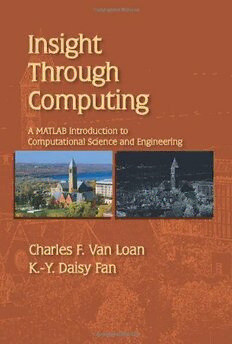Table Of ContentInsight
Through
Computing
Insight
Through
Computing
A MATLAB Introduction to
Computational Science and Engineering
Charles F. Van Loan
K.-Y. Daisy Fan
Cornell University
Ithaca, New York
Society for Industrial and Applied Mathematics
Copyright © 2010by the Society for Industrial and Applied Mathematics
10 9 8 7 6 5 4 3 2 1
All rights reserved. Printed in the United States of America. No part of this book may be
reproduced, stored, or transmitted in any manner without the written permission of the
publisher. For information, write to the Society for Industrial and Applied Mathematics,
3600 Market Street, 6th Floor, Philadelphia, PA 19104-2688 USA.
Trademarked names may be used in this book without the inclusion of a trademark symbol.
These names are used in an editorial context only; no infringement of trademark is intended.
Java is a trademark of Sun Microsystems, Inc. in the United States and other countries.
MATLAB is a registered trademark of The MathWorks, Inc. For MATLAB product
information, please contact The MathWorks, Inc., 3 Apple Hill Drive, Natick, MA 01760-2098
USA, 508-647-7000, Fax: 508-647-7001, info@mathworks.com, www.mathworks.com.
Big Ben image used courtesy of Wikimedia Commons.
Cover image and Figure 12.13 used with permission of Cornell University Photography.
Library of Congress Cataloging-in-Publication Data
Van Loan, Charles F.
Insight through computing : a MATLAB introduction to computational science and
engineering / Charles F. Van Loan, K.-Y. Daisy Fan.
p. cm.
Includes index.
ISBN 978-0-898716-91-7
1. Numerical analysis--Data processing. 2. Science--Computer simulation.
3. Engineering mathematics--Data processing. 4. MATLAB. I. Fan, K.-Y. Daisy. II. Title.
QA297.V25 2010
005.1--dc22 2009030277
is a registered trademark.
To our families
(cid:2)
Contents
Preface xi
ProgrammingTopics xv
Software xvii
1 From Formula to Program 1
1.1 JustPlugItIn! 3
SurfaceAreaofaSphere
Matlab: Arithmeticexpressions,assignment,input,output
1.2 CheckandEvaluate 14
MinimumofaQuadraticonanInterval
Matlab: Booleanexpressions,conditionals
2 Limits and Error 27
2.1 TilingaDisk 29
Summation
Matlab: Thefor-loop
2.2 Inside/OutsidePolygons 36
Sequences
Matlab: Thewhile-loop
3 Approximation with Fractions 45
3.1 22/7thsandCounting 47
ProximitytoPi
Matlab: Nestedloops,benchmarking
3.2 NotQuitePerfect 56
FibonacciQuotientsandtheGoldenRatio
Matlab: Morecomplicatedwhile-loops
4 The Discrete versus the Continuous 63
4.1 ConnecttheDots 65
PlottingContinuousFunctions
Matlab: Vectors,elementarygraphics
4.2 FromCyantoMagenta 79
ColorComputations
Matlab: rgb
4.3 OneThirdPlusOneThirdIsNotTwoThirds 87
TheFloatingPointEnvironment
Matlab: eps,inf,NaN
vii
viii Contents
5 Abstraction 95
5.1 ReshapingRectangles 97
ASquareandaRoot
Matlab: Simplefunctions
5.2 OvalOdometer 109
EllipsePerimeter
Matlab: Functionswithmultipleinputparameters
5.3 TheBetsyRossProblem 118
DesignParameters
Matlab: Graphicsfunctions
6 Randomness 129
6.1 SafetyinNumbers 131
MonteCarloSimulation
Matlab: Morepracticewithbooleanexpressions
6.2 DiceandCompass 143
RandomWalks
Matlab: Morepracticewithwhile-loops
6.3 OrderfromChaos 149
PolygonAveraging
Matlab: Morepracticewithgraphicsandvectors
7 The Second Dimension 155
7.1 FromHeretoThere 157
TransitionMatrices
Matlab: Two-dimensionalarrays
7.2 ContoursandCrossSections 166
VisualizingF(x,y)
Matlab: Contourplotting
7.3 CoolIt! 171
SimulationonaGrid
Matlab: A(i,j)updating
8 Reordering 179
8.1 CutandDeal 181
ThePerfectShuffle
Matlab: Morepracticewithvectorsandsubscripting
8.2 SizePlace 188
Sorting
Matlab: sort
Contents ix
9 Search 197
9.1 PatternsinProteins 199
LinearSearch
Matlab: Characterarrays
9.2 ARomanNumeralPhoneBook 208
BinarySearch
Matlab: Cellarrays
9.3 ChangingSign 219
BisectingforRoots
Matlab: Functionsasparameters
10 Points, Polygons, and Circles 227
10.1 HowFar? 229
DistanceMetrics
Matlab: Simplestructures
10.2 FencedinTwice? 237
Intersection
Matlab: Morecomplicatedstructures,boolean-valuedfunctions
10.3 NotPerfect? 244
NearnessinShape
Matlab: Practicewithstructures
11 Text File Processing 255
11.1 LatitudeandDaylight 257
DataAcquisitionandConversion
Matlab: Readingdatafromatextfile
11.2 NearbyMillions 268
WritingandRepresentation
Matlab: Creating.datand.binfiles
12 The Matrix: Part II 283
12.1 SavingPrivateRainbows 285
LinearInterpolationandColorMapping
Matlab: row-by-rowmatrixsetup
12.2 KnownontheCorner 292
BilinearInterpolationandShading
Matlab: fromf(x,y)toF(i,j)
12.3 Seven-by-Five 299
ImageDigitization
Matlab: Cellarraysofmatrices
12.4 PictureThis 306
WorkingwithImageDataFiles
Matlab: imread,imwrite,morepracticewithmatrices
x Contents
13 Acoustic File Processing 319
13.1 TheClockStrikes 321
AcquisitionandPlayback
Matlab: wavread,sound,wavwrite
13.2 DialNforNoise 326
FrequencyandSampling
Matlab: Morepracticewithvectors
14 Divide and Conquer 335
14.1 PatternswithinPatterns 337
RecursiveTiling
Matlab: Recursivefunctions
14.2 NandHalfN 344
MergeSort
Matlab: Morepracticewithrecursion
14.3 LookingforTrouble 354
AdaptiveInterpolation
Matlab: Stillmorepracticewithrecursion
15 Optimization 363
15.1 ShortestRoute 365
TheCombinatoricExplosion
Matlab: Morepracticewitharrays
15.2 BestBike 372
ConstraintsandObjectiveFunctions
Matlab: Morecomplicatednestedloops
15.3 MostLikelyOrbit 381
ModelBuilding
Matlab: Interactivesearch
AppendixA. Refined Graphics 389
Appendix B. Mathematical Facts 411
Appendix C.MATLAB,Java, and C 417
Appendix D. Exit Interview 423
Index 425
Preface
Asthetitlesuggests, thisbookisbothanintroductiontoMatlab(cid:1)r programmingandto
thecomputationalsideofscienceandengineering. Wetargetcollegefreshmanintending
tomajorinengineering(includingcomputerscience)oranaturalscience(includingmath-
ematics). Given the quantitative abilities of this group of students, we do not shy away
fromtrigonometryandelementarynotionsofapproximationasseeninCalculusI.Indeed,
itisagainstthegrainofliberaleducationnottointermingleintroductoryprogrammingwith
continuousmathematicsifthestudentclienteleiscapableofhandlingthemix. Liberaledu-
cationisallaboutacquiringanappreciationfordifferentmodesofthought. Whysquander
theopportunitytocontrastdigitalthinkingwithcontinuousthinking?
Ourapproachissimple. Eachsectionbeginswiththeposingofaproblemthatpoints
tosomelargercomputationalstory. Thesolutioniscarefullyderivedandalongthewaywe
introduce whatever new Matlab is required. This is followed by a brief “talking point”
thatemphasizessomeaspectofthelargerstory. Thispatternresonateswithourbeliefthata
firstcourseinprogrammingshouldbetaughtthroughexamples. Everysectionculminates
intheproductionofaworkingMatlabscriptand(usually)afewMatlabfunctions. The
sectionexercisesincludestraightforward“M-problems”thatfocusonthedevelopedcode
and whatever new Matlab is developed. More involved “P-problems” are designed to
reinforcethesection’scomputationalmessage.
We use the Matlab environment because of its friendliness to the first-time pro-
grammer and because it supports the idea of playing with computational ideas through
experimentation. Thisiscentraltothedevelopmentofcomputationalintuition.
Playingwithprogramsbuildscomputationalintuition.
Intuitionisasenseofdirectionnodifferentfromthesenseofdirectionthatenablesyouto
findyourwayaroundanoldchildhoodneighborhoodwithoutamap. Thekeyisthatyou
havebeentherebefore. Ifintuitionisasenseofdirection,thencomputationalintuitionisa
senseofcomputationaldirection. Thosewhohaveitwillbeabletofindtheirwayaround
scienceandengineeringinthe21stcentury. Navigationrequiresfivekeensenses. Through
examplesandproblemsweaimtodothefollowing:
1. Develop eyes for the geometric. The ability to visualize is very important to the
computationalscientist. Ofcourse,computergraphicsplaysatremendousrolehere,
butthevisualizationtoolsthatitoffersdonotobviatetheneedtoreasoningeometric
terms. It is critical to be familiar with sines and cosines, polygons and polyhedra,
metricsandproximity,etc.
2. Developanearthatcanhearthe“combinatoricexplosion.” Manydesignandopti-
mizationproblemsinvolvehugesearchspaceswithanexponentialnumberofpossi-
bilities. Itisimportanttoanticipatethiscomplexityandtohavethewherewithalto
handleitwithintelligentheuristics.
xi
xii Preface
3. Developatastefortherandom. Scienceandengineeringispopulatedwithprocesses
thathavearandomcomponent. Havingasenseofprobabilityandtheabilitytogather
andinterpretstatisticswiththecomputerisvital.
4. Developanosefordimension. Simulationismuchmorecomputationallyintensive
inthreedimensionsthanintwodimensions—ahardfactoflifethatisstaringmany
computationalscientistsrightintheface. Anaccurateimpressionofhowcomputers
assist in the understanding of the physical world requires an appreciation of this
point. Moreover, being able to think at the array level is essential for effective,
high-performancecomputing.
5. Developatouchforwhatisfinite,inexact,andapproximate. Roundingerrorsattend
floatingpointarithmetic,computerdisplaysaregranular,analyticderivativesareap-
proximatedwithdivideddifferences,apolynomialisusedinlieuofthesinefunction,
andthedataacquiredinalabmayonlybecorrecttothreesignificantdigits. Lifein
computationalscienceislikethisandthepractitionermustberesoluteenoughtoface
suchuncertainties. Steadyfootworkisrequiredonthebalancebeamthatseparates
thecontinuousandthediscrete.
While the development of these five senses is an explicit priority, our overarching
ambitionistocommunicatetheexcitementofcomputingtogetherwithanappreciationfor
itsconstraintsanditsconnectionstoothermethodologies. Theinterplaybetweencomputing,
theory,andexperimentationisparticularlyimportant.
Computation
Theory Experiment
Each vertex represents a style of research and provides a window through which we can
viewscienceandengineeringinthelarge. Thevibrancyofwhatweseeinsidethetriangle
dependsupontheideasthatflowarounditsedges. Agoodtheorycouchedinthelanguage
ofmathematicsmayberealizedintheformofacomputerprogram,perhapsjusttoaffirm
its correctness. Running the program results in a simulation that may suggest a physical
experiment. The experiment in turn may reveal a missed parameter in the underlying
mathematicalmodel,andaroundwegoagain.
There are also interesting dynamics in the other direction. Aphysical experiment
mayberestrictedinscopeforreasonsofbudgetorsafety,sothesceneshiftstocomputer
simulation. Theactofwritingtheprogramtoperformthesimulationwillmostlikelyhave
aclarifyinginfluence, promptingsomenewmathematicalpursuit. Innovativemodelsare
discovered,leadingtoamodificationoftheinitialsetofexperiments,andsoforth.
Inthinkingaboutthesecriticalinteractionsweareremindedofthegreatmathematical
scientist Richard Hamming, who stated in the 1960s that “the purpose of computing is
insight,notnumbers.” Weareinobviousagreementwiththispointofview. Thetakeaway

